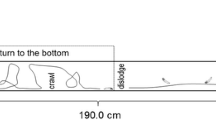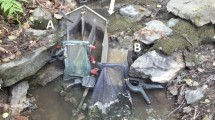Abstract
Understanding the trait adaptations associated with mobility in Trichoptera larvae under different flow conditions would enhance the understanding of survival mechanisms under flow stress induced by spates. In stream mesocosms, we mimicked a lowland stream spate by suddenly increasing current velocity above an organic habitat patch from 10 to 30 or 50 cm/s. Subsequently, we investigated whether short-term, small-scale movements in six Trichoptera species were not random but directional and whether the type of movement was related to the magnitude of flow increase. Main types of response distinguished were as follows: (1) resistance, in which the species remained in the habitat patch, (2) upstream or downstream crawling, and (3) being dislodged from the streambed and drift downstream (vulnerability). The type of response observed was related to the species’ ecological preferences and morphological traits. The experiment showed that movement in Trichoptera larvae was directional and flow-dependent. Drift was the main mechanism observed with an increase in current velocity, but upstream crawling and aggregation in the habitat patch were observed as well. The type and magnitude of the response were highly species specific. It appeared that each combination of morphological and behavioral adaptations developed individually for each species under niche-specific conditions.



Similar content being viewed by others
References
Allan, J. D., 1978. Trout predation and the size composition of stream drift. Limnology and Oceanography 23: 1231–1237.
Badri, A., J. Giudicelli & G. Prevot, 1987. Effects of flood on the benthic macroinvertebrate community in a Mediterranean river, the Rdat (Morocco). Acta Ecologica-Ecologia Generalis 8: 481–500.
Bishop, J. E. & H. B. N. Hynes, 1969. Upstream movements of the benthic invertebrates in the Speed River, Ontario. Journal of the Fisheries Research Board of Canada 26: 279–298.
Bohle, H. W., 1978. Relation between food supply, drift and microdistribution of larvae of Baetis rhodani – investigations in a stream model. Archiv fur Hydrobiologie 84: 500–525.
Borchardt, D., 1993. Effects of flow and refugia on drift loss of benthic macroinvertebrates: implications for habitat restoration in lowland streams. Freshwater Biology 29: 221–227.
Borchardt, D. & B. Statzner, 1990. Ecological impact of urban stormwater runoff studied in experimental flumes: Population loss by drift and availability of refugial space. Aquatic Sciences 52: 299–314.
Buffin-Bélanger, T., I. Reid, S. P. Rice, J. H. Chandler & J. Lancaster, 2003. A casting procedure for reproducing coarse-grained sedimentary surfaces. Earth Surface Processes and Landforms 28: 787–796.
Buffin-Bélanger, T., S. Rice, I. Reid & J. Lancaster, 2006. Spatial heterogeneity of near-bed hydraulics above a patch of river gravel. Water Resources Research 42: W04413. doi:10.1029/2005WR004070.
Ciborowski, J. H., 1979. The effects of extended photoperiods on the drift of the mayfly Ephemerella subvaria McDunnough (Ephemeroptera: Ephemerellidae). Hydrobiologia 62: 209–214.
Denny, M. W., 1988. Biology and the Wave-Swept Environment. Princeton University Press, Princeton, NJ.
Fenoglio, S., P. Agosta, T. Bo & M. Cucco, 2002. Field experiments on colonization and movements of stream invertebrates in an Apennine river (Visone, NW Italy). Hydrobiologia 474: 125–130.
Fisher, R. A., 1954. Statistical Methods for Research Workers, 12th ed. Oliver and Boyd, Edinburgh.
Gordon, N. D., T. A. McMahon & B. L. Finlayson, 2004. Stream Hydrology. An Introduction for Ecologists, 2nd ed. Wiley, Chichester.
Graf, W., J. Murphy, J. Dahl, C. Zamora-Muñoz & M. J. López-Rodríguez, 2008. In Schmidt-Kloiber, A. & D. Hering (eds), Distribution and Ecological Preferences of European Freshwater Organisms, Vol. 1 – Trichoptera. Pensoft Publishers, Sofia-Moscow: 388 pp.
Hansell, M. H., 1968. The house building behaviour of the caddis-fly larva Silo pallipes Fabricius. I: the structure of the house and method of house extension. Animal Behaviour 16: 558–561.
Hart, D. D. & R. A. Merz, 1998. Predator-prey interactions in a benthic stream community: a field test of flow-mediated refuges. Oecologia 114: 263–273.
Hart, D. D., B. D. Clark & A. Jasentuliyana, 1996. Fine-scale field measurement of benthic flow environments inhabited by stream invertebrates. Limnology and Oceanography 41: 297–308.
Hershey, A. E., J. Pastor, B. J. Peterson & G. W. Kling, 1993. Stable isotopes resolve the drift paradox for Baetis mayflies in an Arctic River. Ecology 74: 2315–2325.
Hildrew, A. G. & C. R. Townsend, 1980. Aggregation and foraging by larvae of Plectrocnemia conspersa (Trichoptera: Polycentropodidae). Animal Behaviour 28: 553–560.
Hildrew, A. G., M. K. Dobson, A. Groom, A. Ibbotson, J. Lancaster & S. D. Rundle, 1991. Flow and retention in the ecology of stream invertebrates. Verhandlungen der Internationalen Vereinigung fur Theoretische und Angewandte Limnologie 24: 1742–1747.
Holomuzki, J. R. & B. J. F. Biggs, 2000. Taxon-specific responses to high-flow disturbance in streams: implications for population persistence. Journal of the North American Benthological Society 19: 670–679.
Kohler, S. L., 1984. Search mechanism of a stream grazer in patchy environments, the role of food abundance. Oecologia 62: 209–218.
Kohler, S. L., 1985. Identification of stream drift mechanism, an experimental and observational approach. Ecology 66: 1749–1761.
Kopp, M., J. M. Jeschke & W. Gabriel, 2001. Exact compensation of stream drift as an evolutionarily stable strategy. Oikos 92: 522–530.
Lancaster, J., 1999. Small scale movements of lotic macroinvertebrates with variations in flow. Freshwater Biology 41: 605–619.
Lancaster, J., 2008. Movement and dispersion of insects in stream channels, what role does flow play? In Lancaster, J. & R. A. Briers (eds), Aquatic Insects, Challenges to Populations. CAB International, Wallingford: 139–157.
Lancaster, J. & A. G. Hildrew, 1993. Flow refugia and the microdistribution of lotic macroinvertebrates. Journal of North American Benthological Society 12: 385–393.
Lancaster, J., A. G. Hildrew & C. Gjerlov, 1996. Invertebrate drift and longitudinal transport processes in streams. Canadian Journal of Fisheries and Aquatic Sciences 53: 572–582.
Lancaster, J., T. Buffin-Bélanger, I. Reid & S. P. Rice, 2006. Flow- and substratum-mediated movement by a stream insect. Freshwater Biology 51: 1053–1069.
Mackay, R. J. & G. B. Wiggins, 1973. Ecological diversity in Trichoptera. Annual Review of Entomology 24: 185–208.
Müller, K., 1974. Stream drift as a chronobiological phenomenon in running water ecosystems. Annual Review of Ecology and Systematics 5: 309–323.
Müller, K., 1982. The colonization cycle of freshwater insects. Oecologia 52: 202–207.
Negishi, J. N. & J. S. Richardson, 2006. An experimental test of the effects of food resources and hydraulic refuge on patch colonization by stream macroinvertebrates during spates. Journal of Animal Ecology 75: 118–129.
Neves, R. J., 1979. Movements of larval and adult Pycnopsyche guttifer (Walker) (Trichoptera, Limnephilidae) along Factory Brook, Massachusettes. American Midland Naturalist 102: 51–58.
Olden, J. D., A. L. Hoffman, J. B. Monroe & N. L. Poff, 2004. Movement behavior and dynamics of an aquatic insect in a stream benthic landscape. Canadian Journal of Zoology 82: 1135–1146.
Otto, C. & P. Sjöström, 1986. Behaviour of drifting insect larvae. Hydrobiologia 131: 77–86.
Pearson, R. G. & N. V. Jones, 1987. Short-term movements of chalk-stream invertebrates. Freshwater Biology 18: 559–568.
Pickett, S. T. A. & P. S. White, 1985. The Ecology of Natural Disturbance and Patch Dynamics. Academic Press, Orlando, FL.
Poff, N. L. & J. V. Ward, 1991. Drift responses of benthic invertebrates to experimental streamflow variation in a hydrologically stable stream. Canadian Journal of Fisheries and Aquatic Sciences 48: 1926–1936.
Prestidge, R. A. 1977. Case-building behaviour of Pycnocentrodes aeris (Trichoptera: Sericostomatidae). The New Zealand Entornologist 6: 296–301.
Pulliam, H. R., 1988. Sources, sinks and population regulation. American Naturalist 132: 652–661.
Rice, S. P., T. Buffin-Bélanager, J. Lancaster & I. Reid, 2008. Movements of a macroinvertebrate (Potamophylax latipennis) across a gravelbed substrate, effects of local hydraulics and microtopography under increasing discharge. In Habersack, H., T. Hoey, H. Piegay & M. Rinaldi (eds), Gravel-Bed Rivers, from Process Understanding to River Restoration. Elsevier BV, Amsterdam: 637–660.
Sedell, J. R., G. H. Reeves, F. R. Hauer, J. A. Stanford & C. P. Hawkins, 1990. Role of refugia in recovery from disturbances, modern fragmented and disconnected river systems. Environmental Management 14: 711–724.
Sih, A. & D. E. Wooster, 1994. Prey behavior, prey dispersal and predator impacts on stream prey. Ecology 75: 1207–1217.
Söderström, O., 1987. Upstream movements of invertebrates in running waters – a review. Archiv für Hydrobiologie 111: 197–208.
Statzner, B., 1988. Growth and Reynolds number of lotic macroinvertebrates: a problem for adaptation of shape to drag. Oikos 51: 84–87.
Stuart, E. & D. C. Currie, 2001. Using caddisfly (Trichoptera) case-building behaviour in higher level phylogeny reconstruction. Canadian Journal of Zoology 79: 1842–1854.
Tomaszewski, C., 1973. Studies on the adaptive evolution of the larvae of Trichoptera. Acta Zoologica Cracoviensia 18: 1–93.
Townsend, C. R., 1980. The Ecology of Streams and Rivers Studies in Biology 122. Edward Arnold, London.
Townsend, C. R. & A. G. Hildrew, 1976. Field experiments on the drifting, colonization and continuous redistribution of stream benthos. Journal of Animal Ecology 45: 759–772.
Townsend, C. R. & A. G. Hildrew, 1994. Species traits in relation to a habitat templet for river systems. Freshwater Biology 31: 265–275.
Verdonschot, P. F. M., & R. C. Nijboer, 2004. Macrofauna en vegetatie van de Nederlandse beken. Een aanzet tot beoordeling van de ecologische toestand. Wageningen, Alterra, Alterra-rapport: 756 pp.
Verdonschot, P. F. M., A. A. Besse-Lototskaya, D. B. M. Dekkers & R. C. M. Verdonschot, 2012. Mobility of lowland stream Trichoptera under experimental habitat and flow conditions. Limnologica 42: 227–234.
Vogel, S., 1994. Life in Moving Fluids, 2nd ed. Princeton University Press, Princeton, NJ.
Walton, Jr., O. E., S. R. Reice & R. W. Andrews, 1977. The effects of density, sediment particle size and velocity on drift of Acroneuria abnormis (Plecoptera). Oikos 28: 291–298.
Waringer, J. A., 1989. Resistance of a cased caddis larva to accidental entry into the drift: the contribution of active and passive elements. Freshwater Biology 21: 411–420.
Wiley, M. J. & S. L. Kohler, 1981. An assessment of biological interactions in an epilithic stream community using time-lapse cinematography. Hydrobiologia 74: 183–188.
Williams, D. D. & H. B. N. Hynes, 1976. The recolonization mechanisms of stream benthos. Oikos 27: 265–272.
Wilzbach, M. A., K. W. Cummins & R. Knapp, 1988. Towards a functional classification of stream invertebrate drift. Internationale Vereinigung fur theoretische und angewandte Limnologie Verhandlungen 23: 1244–1254.
Winterbottom, J. H., S. E. Orton & A. G. Hildrew, 1997. Field experiments on the mobility of benthic invertebrates in a southern English stream. Freshwater Biology 38: 37–47.
Acknowledgements
This study was part of the European Framework Program REFRESH (Grant Agreement No. 244121), funded by the European Union. We thank the Dutch Ministry of Economic Affairs, project number KB-14-002-036, for additional basic research funding.
Author information
Authors and Affiliations
Corresponding author
Additional information
Handling editor: Sonja Stendera
Rights and permissions
About this article
Cite this article
Verdonschot, P.F.M., Besse-Lototskaya, A.A., Dekkers, T.B.M. et al. Directional movement in response to altered flow in six lowland stream Trichoptera. Hydrobiologia 740, 219–230 (2014). https://doi.org/10.1007/s10750-014-1955-9
Received:
Revised:
Accepted:
Published:
Issue Date:
DOI: https://doi.org/10.1007/s10750-014-1955-9




